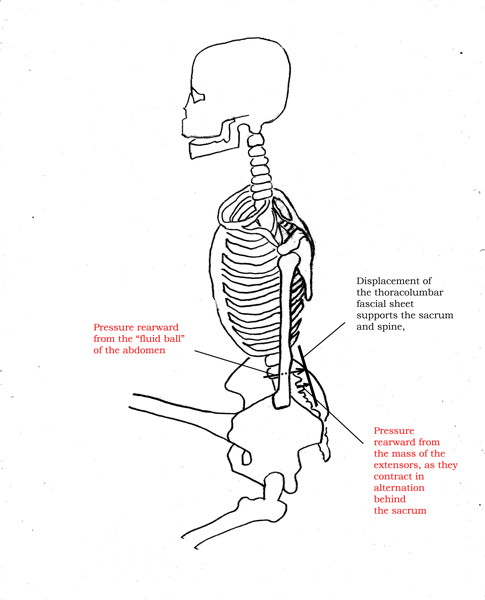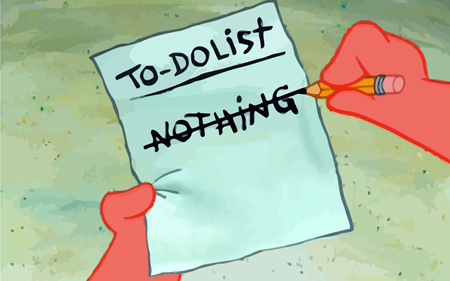-
Content count
3,312 -
Joined
-
Last visited
-
Days Won
12
Posts posted by Mark Foote
-
-
20 hours ago, Tommy said:QuoteWhy do I suddenly feel like Oscar Zoroaster Phadrig Isaac Norman Henkle Emmannuel Ambroise Diggs?
Yeah, all that makes me think of the guy who is holding onto a rope which is anchored on a roof edge. The guy is holding onto the other end of the rope. All the while standing on the rope and walking out into the middle of nowhere. Up in the air by holding onto the rope? Yea, fancy words and lots of dancing around to produce a wonderful show. All of which still makes no sense to me. I guess I am lost and always will be.
Beat me, whip me, make me write bad checks.
Quote
On 11/12/2025 at 2:42 PM, Tommy said:
Well, you seem to know what spirituality means. What is the spirit and how do I find it in myself?
As I mentioned, the word "spirit" is derived from words for the breath. I would say, spirit is the necessity in the movement of breath.
As to how you find it, if you feel you have lost track of it... As Shunryu Suzuki said, following the breath is only a preparatory practice:
… usually in counting breathing or following breathing, you feel as if you are doing something, you know– you are following breathing, and you are counting breathing. This is, you know, why counting breathing or following breathing practice is, you know, for us it is some preparation– preparatory practice for shikantaza because for most people it is rather difficult to sit, you know, just to sit.
(“The Background of Shikantaza”, Shunryu Suzuki; San Francisco, February 22, 1970)
Suzuki described shikantaza in more detail:
So most teacher may say shikantaza is not so easy, you know. It is not possible to continue more than one hour, because it is intense practice to take hold of all our mind and body by the practice which include everything. So in shikantaza, our mind should pervade every parts of our physical being. That is not so easy.
(“I have nothing in my mind”, Shunryu Suzuki, July 15, 1969)
Gautama spoke similarly about the mind pervading the body:
… seated, (one) suffuses (one’s) body with purity by the pureness of (one’s) mind so that there is not one particle of the body that is not pervaded with purity by the pureness of (one’s) mind.
(AN 5.28, tr. PTS vol. III pp 18-19, parentheticals paraphrase original)
“The pureness of mind” Gautama referred to is the pureness of the mind without any will or intent with regard to the activity of the body.
In Gautama’s teaching, the extension of “purity by the pureness of mind” belonged to the last of four concentrations. The initial concentration is induced, said Gautama, by “making self-surrender the object of thought”:
… the (noble) disciple, making self-surrender the object of (their) thought, lays hold of concentration, lays hold of one-pointedness. (The disciple), aloof from sensuality, aloof from evil conditions, enters on the first trance, which is accompanied by thought initial and sustained, which is born of solitude, easeful and zestful, and abides therein.
(SN 48.10, tr. PTS vol V p 174; parentheticals paraphrase original; “initial” for “directed”, as at SN 36.11, tr. PTS vol IV p 146)
In my experience, “one-pointedness” occurs when the movement of breath necessitates the placement of attention at a singular location in the body, and a person “lays hold of one-pointedness” when they remain awake as the singular location shifts.
Gautama described the “first trance” as having feelings of zest and ease, and he prescribed the extension of those feelings:
… (a person) steeps, drenches, fills, and suffuses this body with zest and ease, born of solitude, so that there is not one particle of the body that is not pervaded by this lone-born zest and ease.
(AN 5.28, tr. PTS vol. III pp 18-19, parentheticals paraphrase original)
Words like “steeps” and “drenches” convey that the weight of the body accompanies the feelings of zest and ease.
The weight of the body sensed at a particular point in the body can shift the body’s center of gravity, and a shift in the body’s center of gravity can result in what Moshe Feldenkrais termed “reflex movement”. Feldenkrais described how “reflex movement” can be engaged in standing up from a chair:
…When the center of gravity has really moved forward over the feet a reflex movement will originate in the old nervous system and straighten the legs; this automatic movement will not be felt as an effort at all.
(“Awareness Through Movement”, Moshe Feldenkrais, p 78)
“Drenching” the body “so that there is not one particle of the body that is not pervaded” with zest and ease allows the weight of the body to effect “reflex movement” in the activity of the body, wherever “one-pointedness” takes place.
In falling asleep, the mind can sometimes react to hypnagogic sleep paralysis with an attempt to reassert control over the muscles of the body, causing a “hypnic jerk”. The extension of a weighted zest and ease can pre-empt the tendency to reassert voluntary control in the induction of concentration, and make possible a conscious experience of “reflex movement” in inhalation and exhalation.
If you want to get in touch with spirit, relinquish volition in the activity of the body until you have conscious experience of “reflex movement” in inhalation and exhalation, from inbreath to outbreath and from outbreath to inbreath.
If you want to be in touch with the "great spirit", then do the above, and extend friendliness and compassion without limit:[One] dwells, having suffused the first quarter [of the world] with friendliness, likewise the second, likewise the third, likewise the fourth; just so above, below, across; [one] dwells having suffused the whole world everywhere, in every way, with a mind of friendliness that is far-reaching, wide-spread, immeasurable, without enmity, without malevolence. [One] dwells having suffused the first quarter with a mind of compassion… with a mind of sympathetic joy… with a mind of equanimity that is far-reaching, wide-spread, immeasurable, without enmity, without malevolence.
(MN 111; tr. Pali Text Society vol III p 79)
Gautama said that “the excellence of the heart’s release” through the extension of the mind of compassion was the first of the further concentrations, a concentration he called “the plane of infinite ether” (MN 111; tr. Pali Text Society vol III p 79).
The Oxford English Dictionary offers some quotes about “ether” (Oxford English Dictionary, s.v. “ether (n.),” March 2024):
They [sc. the Brahmins] thought the stars moved, and the planets they called fishes, because they moved in the ether, as fishes do in water.
(Vince, Complete System. Astronomy vol. II. 253 [1799])
Plato considered that the stars, chiefly formed of fire, move through the ether, a particularly pure form of air.
(Popular Astronomy vol. 24 364 [1916])
When the free location of consciousness is accompanied by an extension of the mind of compassion, there can be a feeling that the necessity of breath is connected to things that lie outside the boundaries of the senses. That, to me, is an experience of “the plane of infinite ether”.
(The Inconceivable Nature of the Wind)
and the way to let the great spirit move me.
-
On 10/27/2025 at 12:33 PM, Kati said:
this is beautiful. it reminds me on how master chunyi lin teaches energy healingwould you say that the following is true? do you have experience with applying this?
Master Chunyi Lin’s teachings, especially the integration of unconditional love (often referred to as Zhen Qi or true/original Qi) is not only for physical or emotional healing but also for transforming life circumstances.
In the Spring Forest Qigong system, energy work isn’t just about clearing blockages in the body—it’s about aligning your entire being with the flow of unconditional love, which is seen as the highest vibrational energy and the essence of the universe. When you bring that energy into your life pursuits—whether it’s your career, relationships, creative expression, or inner peace—you’re not forcing outcomes; you’re dissolving energetic resistance and opening channels for divine intelligence (or what some call “heaven’s will”) to move through you.
The practices you list sound like a great way to keep yourself together, in what can sometimes seem like the overwhelming noise and now the anonymity of the modern world.
Good luck, if you are job searching! -
1 hour ago, Tommy said:
Well, you seem to know what spirituality means. What is the spirit and how do I find it in myself?
Why do I suddenly feel like Oscar Zoroaster Phadrig Isaac Norman Henkle Emmannuel Ambroise Diggs?

Alias, "The Wizard of Oz"!
All kidding aside, be careful what you wish for.
I am hoping to publish my book soon, and my producer thought a biography would be a good thing. This is what I came up with:
My life has been 50 years trying to figure out how the zazen that gets up and walks around fits into a normal life, and likewise trying to figure out how zazen sits zazen so I can sit as long as I feel I need to sit without wrecking my knees.
As to "spirit":
Middle English: from Anglo-Norman French, from Latin spiritus ‘breath, spirit’, from spirare ‘breathe’.
(Oxford Languages, dictionary publisher)
I stumbled into the zazen that gets up and walks around by telling myself I was going to be aware of every breath in and every breath out all day long for an entire day, back in '75. You can read my take on all that, in my The Inconceivable Nature of the Wind.
That wasn't the same as discovering zazen sitting zazen, for me. My best take on that is Just to Sit.
That's going to be the last essay in my book before the appendix. The whole thing is A Natural Mindfulness, absolutely free to download, hopefully coming soon to Amazon as a paperback. Turns out, they'll publish anything, so it might happen.
The book opens with Waking Up and Falling Asleep. I continue to believe that's the best place to find it.
-
-
On 11/6/2025 at 6:18 PM, Tommy said:I am not that sophisticated to understand the difference between "Yes- but-mind" and "Don't-know-mind". So correct me if I am wrong. The whole thing seems to be about the attitude in which one approaches the sitting?? Or is there something else I am missing?
Yeah, it's easy to overthink this (ha ha).
My take is that there's a certain negation in "don't know mind", because the mind does know, that's it's nature. And a certain affirmation in "'yes, but' mind".Some teachers say "root out discursive thought". Gautama described mindfulness of mind in a more affirmative light, IMO:
Aware of mind I shall breathe in. Aware of mind I shall breathe out.
(One) makes up one’s mind:
“Gladdening my mind I shall breathe in. Gladdening my mind I shall breathe out.
Composing my mind I shall breathe in. Composing my mind I shall breathe out.
Detaching my mind I shall breathe in. Detaching my mind I shall breathe out.
(SN 54.1, tr. Pali Text Society vol V pp 275-276)
In my experience, that sequence is natural, and any attempt on my part to "root out" a particular kind of thought leads me in a loop of thought.
Gautama spoke of observing the mind the way the king's chef observes the king, to see what he favors on a given day and what he does not. He also said:
As (one) abides in body contemplating body, either some bodily object arises, or bodily discomfort or drowsiness of mind scatters (one’s) thoughts abroad to externals. Thereupon… (one’s) attention should be directed to some pleasurable object of thought. As (one) thus directs it to some pleasurable object of thought, delight springs up in (one’s being). In (one), thus delighted, arises zest. Full of zest (one’s) body is calmed down. With body so calmed (one) experiences ease. The mind of one at ease is concentrated. (One) thus reflects: The aim on which I set my mind I have attained. Come, let me withdraw my mind [from pleasurable object of thought]. So (one) withdraws (one’s) mind therefrom, and neither starts nor carries on thought-process. Thus (one) is fully conscious: I am without thought initial or sustained. I am inwardly mindful. I am at ease.
(Gautama repeats the above for “As (one) contemplates feelings in feelings…”, “… mind in mind…”, “… mind-states in mind-states, either some mental object arises, or…”)
Such is the practice for the direction of mind.
And what… is the practice for the non-direction of mind? (First,) by not directing (one’s) mind to externals, (one) is fully aware: My mind is not directed to externals. Then (one) is fully aware: My mind is not concentrated either on what is before or on what is behind, but it is set free, it is undirected. Then (one) is fully aware: In body contemplating body I abide, ardent, composed and mindful. I am at ease.
And (one) does the same with regard to feelings… to mind… and mind-states. Thus (one) is fully aware: In mind-states contemplating mind-states I abide, ardent, composed and mindful. I am at ease.
This is the practice for the non-direction of mind.
(SN 47.10, tr. Pali Text Society SN V pp 135-136)
Maybe you have better luck with "only don't know" than I do!
-
 1
1
-
-
On 11/6/2025 at 7:50 AM, seedling said:So in Buddhism the intention completely ceases but in the Hindu tradition a realized being may choose to direct their energy in different ways.
Volition in the activity of speech, body and mind completely ceases, in successive states of concentration:
…I have seen that the ceasing of the activities is gradual. When one has attained the first trance, speech has ceased. When one has attained the second trance, thought initial and sustained has ceased. When one has attained the third trance, zest has ceased. When one has attained the fourth trance, inbreathing and outbreathing have ceased… Both perception and feeling have ceased when one has attained the cessation of perception and feeling.
(SN 36.11, tr. Pali Text Society vol IV p 146)
What ceases is not speech itself, but intention or choice in speech, and similarly for deeds (choice in action of the body, affecting inbreathing and outbreathing), and for mind (choice in perception and feeling).
It is intention that I call deeds. For after making a choice one acts by way of body, speech, and mind.
(AN 6.63, tr. Sujato Bhikkyu)Maybe a better translation, speaking of "action" instead of "deeds" in the first sentence (but "intention" and "choice" are clearer translations than "determinate thought" and "determines") :
…I say that determinate thought is action. When one determines, one acts by deed, word, or thought.
(AN 6.63, tr. Pali Text Society vol III p 294)
Gautama directed his mind in the fourth concentration to various psychic phenomena, that was the basis of his enlightenment:
The Fourth Jhāna
... with the abandoning of pleasure and pain, and with the previous passing away of joy and grief, the bhikkhu enters and dwells in the fourth jhāna, which is neither pleasant nor painful and contains mindfulness fully purified by equanimity. He sits suffusing his body with a pure bright mind, so that there is no part of his entire body not suffused by a pure bright mind.
“Great king, suppose a man were to be sitting covered from the head down by a white cloth, so that there would be no part of his entire body not suffused by the white cloth. In the same way, great king, the bhikkhu sits suffusing his body with a pure bright mind, so that there is no part of his entire body not suffused by a pure bright mind.
Insight Knowledge
“When his mind is thus concentrated, pure and bright, unblemished, free from defects, malleable, wieldy, steady and attained to imperturbability, he directs and inclines it to knowledge and vision. He understands thus: ‘This is my body, having material form, composed of the four primary elements, originating from father and mother, built up out of rice and gruel, impermanent, subject to rubbing and pressing, to dissolution and dispersion. And this is my consciousness, supported by it and bound up with it.’...
The Knowledge of the Mind-made Body
When his mind is thus concentrated, pure and bright, unblemished, free from defects, malleable, wieldy, steady, and attained to imperturbability, he directs and inclines it to creating a mind-made body. From this body he creates another body having material form, mind-made, complete in all its parts, not lacking any faculties....
The Knowledge of the Modes of Supernormal Power
When his mind is thus concentrated, pure and bright, unblemished, free from defects, malleable, wieldy, steady, and attained to imperturbability, he directs and inclines it to the modes of supernormal power. He exercises the various modes of supernormal power: having been one, he becomes many and having been many, he becomes one; he appears and vanishes; he goes unimpeded through walls, ramparts, and mountains as if through space; he dives in and out of the earth as if it were water; he walks on water without sinking as if it were earth; sitting cross-legged he travels through space like a winged bird; with his hand he touches and strokes the sun and the moon, so mighty and powerful; he exercises mastery over the body as far as the Brahma-world....
You get the idea. This goes on, through "Knowledge of the Divine Ear", "Knowledge Encompassing the Minds of Others", "Knowledge of Recollecting Past Lives", "Knowledge of the Divine Eye", and finally concludes with "Knowledge of the Destruction of the Cankers", the cankers being three cravings: “craving for the life of sense”, “craving for becoming”, and “craving for not-becoming” (DN 22; PTS vol. ii p 340). When the cankers are “destroyed”, the roots of the craving for sense-pleasures, the roots of the craving “to continue, to survive, to be” (tr. “bhava”, Bhikkyu Sujato), and the roots of the craving not “to be” (the craving for the ignorance of being) are destroyed.
With the destruction of the cankers, Gautama considered himself enlightened, "having done what was to be done", nothing further "to be done through diligence" (MN 70).
I imagine that's basically the same goal in Hinduism.-
 1
1
-
-
She's discussing something altogether different, but I thought it was worth noting that Sojun Mel Weitsman said this about Shunryu Suzuki's teaching:
He said that the secret of Soto Zen is "yes, but."
("Wind Bell", S. F. Zen Center, vol. XXXlll no. 2 FALL/ WINTER 1999, "introduction to "Branching Streams Flow in the Darkness" BY Mel Weitsman, p 15)
-
On 9/20/2025 at 4:44 PM, seedling said:
Thank you for all the responses.I would not differentiate practices based on the intention, the stages or indicators of progress and the methods used make them more defined. In the hindu tradition, one can attain a rainbow body or immortality or be reborn again, it's the intention of the practitioner.
In Buddhism, lack of desire is the essential ingredient of attainment, as here in connection with the concentrations, or "meditations":
… a good (person] reflects thus: “Lack of desire even for the attainment of the first meditation has been spoken of by [me]; for whatever (one) imagines it to be, it is otherwise” [Similarly for the second, third, and fourth initial meditative states, and for the attainments of the first four further meditative states].
(MN 113, © Pali Text Society vol III pp 92-94)
There is "right intention", or right purpose, but it's complicated:
As to this… right view comes first. And how… does right view come first? If one comprehends that wrong purpose is wrong purpose and comprehends that right purpose is right purpose, that is… right view. And what… is wrong purpose? Purpose for sense-pleasures, purpose for ill-will, purpose for harming. This… is wrong purpose. And what… is right purpose? Now I… say that right purpose is twofold. There is… the right purpose that has cankers, is on the side of merit, and ripens unto cleaving (to new birth). There is… the right purpose which is [noble], cankerless, supermundane, a factor of the Way. And what… is the purpose which is on the side of merit, and ripens unto cleaving? Purpose for renunciation, purpose for non-ill-will, purpose for non-harming. This… is right purpose that… ripens unto cleaving. And what… is the right purpose that is [noble], cankerless, supermundane, a component of the Way? Whatever… is reasoning, initial thought, purpose, an activity of speech through the complete focusing and application of the mind in one who, by developing the [noble] Way, is of [noble] thought, of cankerless thought, and is conversant with the [noble] Way–this… is right purpose that is [noble], cankerless, supermundane, a component of the Way.
(MN 117, tr. Pali Text Society vol III p 115)
You can't get there from here, as far as intending not to be reborn, at least not in the teachings of Gautama the Shakyan.
-
 1
1
-
-
On 11/1/2025 at 2:20 PM, Antares said:QuoteThe stages of the first level are:
“… relaxing the ligaments from the shoulder to the wrist”; “from the hip joint to the heel”; “from the sacrum to the headtop”.(“Three Levels” from “Cheng Tzu’s Thirteen Treatises on Ta’i Chi Chuan”, Cheng Man Ch’ing, tr. Benjamin Pang Jeng Lo and Martin Inn, pp 77-78)
It is not a stage, just requirement.
Take it up with Cheng Man Ch'ing. He described "three different levels of T'ai Chi Chuan" in his "Thirteen Chapters", and said that each level had three degrees. For simplicity's sake, I said "stages" instead of "degrees".
QuoteIMO the first stage is:
The One cavity is the root of the void. It has neither shape nor form. When the original vapor emerges, the cavity appears; when circulation is at rest, the cavity disappears. The One cavity is the place where the sacred is hidden. It is the altar of life, and it has many names—the Palace of the Dragon at the Bottom of the Sea, the Land of the Snowy Mountain, the Western Realm, the Original Gate, the Land of Great Happiness...
from Huiming - jing - one of the Wuliupai texts
Cheng Man Ch'ing's first level described the steps in opening the body to the flow of ch'i. The second level described the flow of ch'i, beginning with "sinking the ch'i to the tan t'ien".
Almost sounds like "the One cavity" is the dan t'ien. Cheng Man Ch'ing does spend some time speculating on what the dan t'ien is, but when he talks about the degrees of the various levels, it's practical instruction rather than description.
-
-
Stages and levels in Tai Chi:
The classic literature of Tai Chi appears to identify the ligaments of the body as a source of activity. The literature describes three levels in the development of “ch’i”, and each of the three levels has three stages.
The stages of the first level are:
“… relaxing the ligaments from the shoulder to the wrist”; “from the hip joint to the heel”; “from the sacrum to the headtop”.
(“Three Levels” from “Cheng Tzu’s Thirteen Treatises on Ta’i Chi Chuan”, Cheng Man Ch’ing, tr. Benjamin Pang Jeng Lo and Martin Inn, pp 77-78)
Unlike the contraction and relaxation of muscles, the stretch and resile of ligaments can’t be voluntarily controlled. The muscles across the joints can, however, be relaxed in such a way as to allow the natural stretch and resile of ligaments–that would seem to be the meaning of the advice to “relax the ligaments”.
The stages of the second level are:
“sinking ch’i to the tan t’ien” (a point below and behind the navel); “the ch’i reaches the arms and legs”; “the ch’i moves through the sacrum (wei lu) to the top of the head (ni wan)”.
(ibid)
Tai Ch’i master Cheng Man Ch’ing advised that the ch’i will collect at the tan-t’ien until it overflows into the tailbone and transits to the top of the head, but he warned against any attempt to force the flow.
Omori Sogen cautioned similarly:
… It may be the least trouble to say as a general precaution that strength should be allowed to come to fullness naturally as one becomes proficient in sitting. We should sit so that our energy increases of itself and brims over instead of putting physical pressure on the lower abdomen by force.
(“An Introduction to Zen Training: A Translation of Sanzen Nyumon”, Omori Sogen, tr. Dogen Hosokawa and Roy Yoshimoto, Tuttle Publishing, p 59)
I would posit that the patterns in the development of ch’i reflect involuntary activity of the body generated in the stretch of ligaments. There is, in addition, a possible mechanism of support for the spine from the displacement of the fascia behind the spine, a displacement that can be effected by pressure generated in the abdominal cavity and that may quite possibly depend on a push on the fascia behind the sacrum by the bulk of the extensor muscles, as they contract.

The final level in the development of ch’i concerns “chin”. According to the classics, “chin comes from the ligaments” (“Cheng Tzu’s Thirteen Treatises on Ta’i Chi Chuan”, as above).
The three stages of the final level are:
“t’ing chin, listening to or feeling strength”; “comprehension of chin”; “omnipotence”.
(ibid)
Another translator rendered the last stage above as “perfect clarity” (“Master Cheng’s Thirteen Chapters on T’ai-Chi Ch’uan”, tr. Douglas Wile, p 57). In my estimation, “perfect clarity” is “the pureness of (one’s) mind” that Gautama associated with ...the fourth concentration.
Gautama’s metaphor for the fourth concentration:
… it is as if (a person) might be sitting down who had clothed (themselves) including (their) head with a white cloth; there would be no part of (their) whole body that was not covered by the white cloth.
(MN 119, © Pali Text Society vol. III p 134)
(Just to Sit)
“Imagine that a lump of soft butter, pure in colour and fragrance and the size and shape of a duck egg, is suddenly placed on the top of your head. As it begins to slowly melt, it imparts an exquisite sensation, moistening and saturating your head within and without. It continues to ooze down, moistening your shoulders, elbows, and chest; permeating lungs, diaphragm, liver, stomach, and bowels; moving down the spine through the hips, pelvis, and buttocks."
(Hakuin's account of Hukuyu's teaching, from "Wild Ivy, The Spiritual Autobiography of Zen Master Hakuin", translated by Norman Waddell. © 1999 by Norman Waddell)I can testify to the sensation of a white cloth covering the head and the entire body. I believe that sensation has its roots in reflex activity of the body as a consequence of the placement of attention by the necessity of breath, reflex activity that works the muscles against the ligaments of the sacrum and spine to align the vertebrae and allow the displacement of the thoracolumbar fascia:
The suffusion of the body with “purity by the pureness of mind” in the fourth concentration can allow the thoracolumbar fascial sheet to sustain an openness of nerve exits along the sacrum and spine. Such an openness is accompanied by an ability to feel throughout the body to the surface of the skin.
There is a relationship between the ease of nerve exits from the sacrum and spine and feeling on the surface of the skin. Here is a chart from the early 1900’s of the specifics of that relationship on the front of the body:
The free placement of attention in the movement of breath depends on an ability to feel throughout the body to the surface of the skin.
(Just to Sit)The emphasis on the collection of ch'i at the lower dan t'ien corresponds to Gautama's second concentration, and to the Rinzai Zen focus on the hara that accompanied Hakuin's practice of the golden egg. That's the emphasis that Omori Sogen warned against, in the passage I quoted above.
I discuss my approach to the concentrations in Applying the Pali Instructions, and again in Just to Sit.
-
On 10/21/2025 at 3:01 AM, Apech said:
Drowning
duct-taping (whatever is waxing and waning, waving, drowning, to Roger Waters' Wall--see? simplified.).
-
 1
1
-
 1
1
-
-
On 10/27/2025 at 5:42 PM, Nungali said:17. ... The material act is but the outward expression of thy thought, and therefore hath it been said that “the thought of foolishness is sin.” Thought is the commencement of action, and if a chance thought can produce much effect, what cannot fixed thought do?
…I say that determinate thought is action. When one determines, one acts by deed, word, or thought.(AN 6.63, tr. Pali Text Society vol III p 294)
And what… is the ceasing of action? That ceasing of action by body, speech, and mind, by which one contacts freedom,–that is called ‘the ceasing of action’.
(SN 35.146, tr. Pali Text Society vol IV p 85)
Fixing thought, nix, nix:
That which we will…, and that which we intend to do and that wherewithal we are occupied:–this becomes an object for the persistance of consciousness. The object being there, there comes to be a station of consciousness. Consciousness being stationed and growing, rebirth of renewed existance takes place in the future, and here from birth, decay, and death, grief, lamenting, suffering, sorrow, and despair come to pass. Such is the uprising of this mass of ill.
Even if we do not will, or intend to do, and yet are occupied with something, this too becomes an object for the persistance of consciousness… whence birth… takes place.
But if we neither will, nor intend to do, nor are occupied about something, there is no becoming of an object for the persistance of consciousness. The object being absent, there comes to be no station of consciousness. Consciousness not being stationed and growing, no rebirth of renewed existence takes place in the future, and herefrom birth, decay-and-death, grief, lamenting, suffering, sorrow and despair cease. Such is the ceasing of this entire mass of ill.
(SN 12.38; © Pali Text Society SN vol. II p 45)
Let the mind be present without an abode.
(Diamond Sutra; translation Venerable Master Hsing Yun, from “The Rabbit’s Horn: A Commentary on the Platform Sutra”, Buddha’s Light Publishing pg. 60)
-
On 10/28/2025 at 6:18 AM, liminal_luke said:Maybe the beauty of having all these "brains" is that we can change what we think without staying strictly in our head. There´s a gut-brain axis? Good! Let me change my thoughts by eating differently. Movement works too as well as various cultivation practices. Getting the right kind of sunshine can have a profound effect on the kind of thoughts associated with a bad mood. It´s often easier to change thoughts indirectly -- by working with the systems that effect the various brains -- than trying to strongarm thoughts on a cognitive level.
Along those lines. The couple in this video got serious scientific support, but a double-blind study will take funds they haven't secured yet.
P.S.--as they say in the video, don't try this at home!
-
-
1 hour ago, ChiDragon said:
What was your point? What do you want to say? "Zazen gets up and walks around?" I don't get it. Do you actually know what Zazen is all about?
I understand that Zazen is a sitting position in three lotus styles. Zazen is not a thing that walks around. However, after the practice and getting up from the lotus position, it is hard to walk for awhile until the legs are returned to the normal walking condition.
I don't sit lotus, bad enough for me getting up from a sloppy half-lotus!Thanks for asking, about my point. The point is that it is possible to act without will, without willing action to take place. That is the action described as "wu wei", so far as I understand it.
As Zen teacher Kobun Chino Otogawa said:
It’s impossible to teach the meaning of sitting. You won’t believe it. Not because I say something wrong, but until you experience it and confirm it by yourself, you cannot believe it.
(“Embracing Mind”, edited by Cosgrove & Hall, p 48)
From Wikipedia:Wu wei (traditional Chinese: 無為; simplified Chinese: 无为; pinyin: wúwéi; Jyutping: mou4-wai4) is an ancient Chinese concept that literally means "actionlessness" or "motionlessness".
The term is interpreted and translated in various ways as "actionlessness", "non-action", "inaction," "without action" or "effortless action", etc.
Wu wei is effortless by virtue of it being reflex or automatic activity, even though the individual is fully conscious of it taking place.
-
 1
1
-
 1
1
-
-
On 10/24/2025 at 10:54 AM, Surya said:Wondering to put this here on in the Christian forum, but since Paul said it perfectly, and there is nothing to substract or add to it, I’ll just share it here:
Quote13 If I speak in the tongues[a] of men or of angels, but do not have love, I am only a resounding gong or a clanging cymbal. 2 If I have the gift of prophecy and can fathom all mysteriesand all knowledge, and if I have a faith that can move mountains, but do not have love, I am nothing. 3 If I give all I possess to the poor and give over my body to hardship that I may boast, but do not have love, I gain nothing.
4 Love is patient, love is kind. It does not envy, it does not boast, it is not proud. 5 It does not dishonor others, it is not self-seeking, it is not easily angered, it keeps no record of wrongs.6 Love does not delight in evil but rejoices with the truth. 7 It always protects, always trusts, always hopes, always perseveres.
8 Love never fails. But where there are prophecies, they will cease; where there are tongues, they will be stilled; where there is knowledge, it will pass away. 9 For we know in part and we prophesy in part, 10 but when completeness comes, what is in part disappears.11 When I was a child, I talked like a child, I thought like a child, I reasoned like a child. When I became a man, I put the ways of childhoodbehind me. 12 For now we see only a reflection as in a mirror; then we shall see face to face.Now I know in part; then I shall know fully, even as I am fully known.
13 And now these three remain: faith, hope and love. But the greatest of these is love.
https://www.biblegateway.com/passage/?search=1 Corinthians 13&version=NIV
Similarly, Bart D. Ehrman, in “The New Testament: A Historical Introduction”, notes that the Corinthian congregation faced numerous issues involving interpersonal conflicts and ethical improprieties.
He states: “The congregation that Paul addresses appears to have been riddled with problems involving interpersonal conflicts and ethical improprieties. His letter indicates that some of its members were at each other’s throats, claiming spiritual superiority over one another.”
(Marko Marina, Ph.D., Exploring 1 Corinthians: Authorship, Summary, and Dating)
Always good to understand the context.I'm always floored by the assumption that everyone understands what "love" is. Paul gives characteristics, but if love is a feeling and a person doesn't feel it, the question is how do they regain it (love, that is)?
-
 1
1
-
-
10 hours ago, ChiDragon said:
Wu Wei is nothing that cannot be done.
Don’t ever think that you can sit zazen! That’s a big mistake! Zazen sits zazen!
(Shunryu Suzuki, quoted by Blanche Hartman in the "Lou and Blanche Hartman" interview by David Chadwick, on cuke.com)
You know, sometimes zazen gets up and walks around.
(Kobun Chino Otogawa, at the close of of a lecture at the S. F. Zen Center, in the 1980's)They do nothing and yet there's nothing left undone.
(translation of 無 為 而 無 不 為 [wu2 wei2 er2 wu2 bu4 wei2], by Cobie [DDJ ch. 48])-
 1
1
-
-
25 minutes ago, Nungali said:Bad tatts be cool - supposedly . A women I met had Sponge Bob tatts ...... Sponge Bob !

Screencap from “The Pink Purloiner” episode of SpongeBob SquarePants.
-
 2
2
-
-
Watch out for nutrition science:
... The stand out example for me is nutrition science. A lot of the big, obvious effects have been picked through and now so much of it is simmering in noise with strong incentives to find various different things by getting significance. Alcohol/chocolate/coffee does, doesn’t, does, doesn’t, does, doesn’t cause increased mortality. I don’t know how we could expect that discipline to turn around. There is good work being done there here and there, but so much of it is GIGO. I have a paper in the works trying to sort out how we can know if a field is producing knowledge or just chasing ghosts . . .
(Joe Bak-Coleman, collective behavior scientist at the University of Washington)... Regarding nutrition science: yeah, this is another field where there’s endless crap being hyped. Also related areas in health science such as that stupid cold-shower study or all the crappy sleep research. I don’t have any sense of an escape route for all this. On one hand, nutrition, health behavior, exercise, sleep, etc., are hugely important and worth scientific study. On the other hand, these fields are so rotten, with really incompetent or unethical people deeply embedded within the system of academic publication and news media promotion, that sometimes it just seems entirely hopeless.
(blog "Statistical Modeling, Causal Inference, and Social Science", today's entry by Andrew Gelman, professor of statistics and political science at Columbia University)
-
 3
3
-
-
50 minutes ago, liminal_luke said:Cool cats rarely follow rules,
or get good grades in public schools.
They cultivate an air of mystery,
not for them the one two three.
So Apech´s drinking wine in Portugal,
and not concerned with us at all.
Let alone the great cat Bastet,
who surely deserves her own sonnet.
meow
A Bastet case, I have becomereading sonnets, having fun
The port is good, so they declare
in Portugal, some cat is there
who sweeps a tail across the rug
and makes a toy of some poor bug

photo Jon Bodsworth
-
 2
2
-
 2
2
-
-
On 10/20/2025 at 3:22 AM, Apech said:The goal is here framed not as bliss or wisdom or even survival but perfect freedom. He can do anything he chooses and come and go as he pleases.
Gautama taught four initial concentrations, and I would say the fourth has a freedom of movement of consciousness in the body. From Just to Sit on my website:
The suffusion of the body with “purity by the pureness of mind” in the fourth concentration can allow the thoracolumbar fascial sheet to sustain an openness of nerve exits along the sacrum and spine. Such an openness is accompanied by an ability to feel throughout the body to the surface of the skin.That’s reflected in Gautama’s metaphor for the fourth concentration:
… it is as if (a person) might be sitting down who had clothed (themselves) including (their) head with a white cloth; there would be no part of (their) whole body that was not covered by the white cloth.
(MN 119, © Pali Text Society vol. III p 134 )There is a relationship between the ease of nerve exits from the sacrum and spine and feeling on the surface of the skin. Here is a chart from the early 1900’s of the specifics of that relationship on the front of the body:

The free placement of attention in the movement of breath depends on an ability to feel throughout the body to the surface of the skin. As I wrote previously:
When a presence of mind is retained as the placement of attention shifts, then the natural tendency toward the free placement of attention draws out thoughts initial and sustained, and brings on the stages of concentration.
(Shunryu Suzuki on Shikantaza and the Theravadin Stages)
The first four concentrations were said to be marked by equanimity with respect to the multiplicity of the senses. The four further concentrations were marked by equanimity with respect to the uniformity of the senses, and the first three were induced by the minds of compassion, of sympathetic joy, and of equanimity "without limit". From my The Inconceivable Nature of the Wind:[One] dwells, having suffused the first quarter [of the world] with friendliness, likewise the second, likewise the third, likewise the fourth; just so above, below, across; [one] dwells having suffused the whole world everywhere, in every way, with a mind of friendliness that is far-reaching, wide-spread, immeasurable, without enmity, without malevolence. [One] dwells having suffused the first quarter with a mind of compassion… with a mind of sympathetic joy… with a mind of equanimity that is far-reaching, wide-spread, immeasurable, without enmity, without malevolence.
(MN 7, tr. Pali Text Society vol I p 48 )
Gautama said that “the excellence of the heart’s release” through the extension of the mind of compassion was the first of the further concentrations, a concentration he called “the plane of infinite ether” (MN 7, tr. Pali Text Society vol I p 48 ).
The Oxford English Dictionary offers some quotes about “ether” (Oxford English Dictionary, s.v. “ether (n.),” March 2024, https://doi.org/10.1093/OED/1514129048 ):
They [sc. the Brahmins] thought the stars moved, and the planets they called fishes, because they moved in the ether, as fishes do in water.
(Vince, Complete System. Astronomy vol. II. 253 [1799])
Plato considered that the stars, chiefly formed of fire, move through the ether, a particularly pure form of air.
(Popular Astronomy vol. 24 364 [1916])
When the free location of consciousness is accompanied by an extension of the mind of compassion, there can be a feeling that the necessity of breath is connected to things that lie outside the boundaries of the senses. That, to me, is an experience of “the plane of infinite ether”.
I'm thinking this is all connected with the freedom of the akh in Egyptian mythology.
-
 1
1
-
-
Sorry to hear of your father's illness and passing, Steve.
Take care of yourself!-
 2
2
-
-
On 10/18/2025 at 8:08 PM, Tommy said:
Yes, I have seen this creeping vines and the never ending narration of my life. Also, how the posture affects the mind. This only makes me know that trying to go forward without a teacher is not going to go well. Twenty to thirty years of practice and still stuck with the creeping vines. So, I positively understand this. Being 66 years old, I think I might have another twenty or so years left to life. And it still won't be enough time. But, I keep trying.When there is such a block that I can not even sit for a minute, I rest and day dream and then I try again. Sometimes, I try to focus my mind and cut off the creeping vines with a mantra I learned long ago. Gate, Gate, Paragate, ParasamGate, Bodhi Svaha. That will get my mind to focus. Then later, back to paying attention to my present with silence. Sometimes, I feel the weakness in my bones and I can not sit. Other times, the peace I feel with the mind quiet, it lets me sit for an hour without realizing the time passing by,
I don't expect change and I don't really want a benefit from just sitting. I just want to feel the quiet and be present. I don't think I could be called a watcher, just sitting, cause there is no sense of time or change. Trying to grasp these moments of quiet make them vanish as quickly as thoughts enter and the mind chases these thoughts. But, got to focus the mind. Then hopefully, will one day drop this mind.
I am late to the dance, too, at 75.
In Gautama’s teaching, the extension of “purity by the pureness of mind” belonged to the last of four concentrations. The initial concentration is induced, said Gautama, by “making self-surrender the object of thought”:
… the (noble) disciple, making self-surrender the object of (their) thought, lays hold of concentration, lays hold of one-pointedness. (The disciple), aloof from sensuality, aloof from evil conditions, enters on the first trance, which is accompanied by thought initial and sustained, which is born of solitude, easeful and zestful, and abides therein.
(SN 48.10, tr. PTS vol V p 174; parentheticals paraphrase original; "initial" for "directed")In my experience, “one-pointedness” occurs when the movement of breath necessitates the placement of attention at a singular location in the body, and a person “lays hold of one-pointedness” when they remain awake as the singular location shifts.
Gautama described the “first trance” as having feelings of zest and ease, and he prescribed the extension of those feelings:
… (a person) steeps, drenches, fills, and suffuses this body with zest and ease, born of solitude, so that there is not one particle of the body that is not pervaded by this lone-born zest and ease.
(AN 5.28, tr. PTS vol. III pp 18-19, parentheticals paraphrase original)
Words like “steeps” and “drenches” convey that the weight of the body accompanies the feelings of zest and ease.
The weight of the body sensed at a particular point in the body can shift the body’s center of gravity, and a shift in the body’s center of gravity can result in what Moshe Feldenkrais termed “reflex movement”. Feldenkrais described how “reflex movement” can be engaged in standing up from a chair:
…When the center of gravity has really moved forward over the feet a reflex movement will originate in the old nervous system and straighten the legs; this automatic movement will not be felt as an effort at all.
(“Awareness Through Movement”, Moshe Feldenkrais, p 78)
“Drenching” the body “so that there is not one particle of the body that is not pervaded” with zest and ease allows the weight of the body to effect “reflex movement” in the activity of the body, wherever “one-pointedness” takes place.
In falling asleep, the mind can sometimes react to hypnagogic sleep paralysis with an attempt to reassert control over the muscles of the body, causing a “hypnic jerk”. The extension of a weighted zest and ease can pre-empt the tendency to reassert voluntary control in the induction of concentration, and make possible a conscious experience of “reflex movement” in inhalation and exhalation.
Gautama offered a metaphor for the first concentration that emphasized the cultivation of one-pointedness. Here’s the full description:
… just as a handy bathman or attendant might strew bath-powder in some copper basin and, gradually sprinkling water, knead it together so that the bath-ball gathered up the moisture, became enveloped in moisture and saturated both in and out, but did not ooze moisture; even so, (a person) steeps, drenches, fills, and suffuses this body with zest and ease, born of solitude, so that there is not one particle of the body that is not pervaded by this lone-born zest and ease.
(AN 5.28, tr. PTS vol. III pp 18-19, parentheticals paraphrase original)
The juxtaposition of a singular bath-ball with the extension of zest and ease such that “there is not one particle of the body that is not pervaded” might seem dissonant, yet in my experience the two can be realized together, and at least initially neither can be sustained alone.
Shunryu Suzuki said, "in shikantaza, our mind should pervade every parts of our physical being." Gautama said, "… seated, (one) suffuses (one’s) body with purity by the pureness of (one’s) mind so that there is not one particle of the body that is not pervaded with purity by the pureness of (one’s) mind."
The difference between "every parts of our physical being" and "not one particle of the body that is not pervaded" is the difference between "all over the body" and "throughout the body":Yun Yen asked Tao Wu, “What does the Bodhisattva of Great Compassion use so many hands and eyes for?”
Wu said, “It’s like somebody reaching back groping for a pillow in the middle of the night.”
Yen said, “I understand.”
Wu said, “How do you understand it?”
Yen said, “All over the body are hands and eyes.”
Wu said, “You have said quite a bit there, but you’ve only said eighty percent of it.”
Yen said, “What do you say, Elder Brother?”
Wu said, “Throughout the body are hands and eyes.”
(“The Blue Cliff Record”, Yuanwu, tr. Cleary & Cleary, Shambala p. 489)
-
 1
1
-






obsolete
in Esoteric and Occult Discussion
Posted
Thank you! The original was a little out of focus, but here it is--down at the Family Duck: